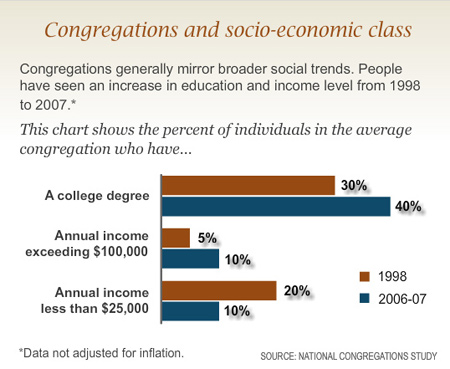
As this graph shows, people in congregations make more money in 2006-07 than they did in 1998. In 1998, the average person attended a congregation in which 20% of people had annual incomes below $25,000 – a number that dropped to 10% in 2006-07. In 1998, the average person attended a congregation in which 5% of people had annual income above $100,000--a number that doubled to 10% by 2006-07.
People in congregations also were, on average, more educated in 2006-07 than they were in 1998. In 1998, the average attendee was in a congregation in which 30% of people were college graduates; by 2006-07, that number had risen to 40%.
But these numbers are misleading. In fact, these numerical differences between 1998 and 2006-07 reflect stability rather than real social change. They do not take inflation into account. Moreover, they closely mirror income and educational trends in the general population. There has not been upward or downward social mobility among American congregations in the last decade. Rather, congregations’ socioeconomic position in American society remains unchanged since 1998.
I do not want to make too much of this socioeconomic stability for congregations, but it does remind me that observers and scholars of American religion often discuss the extent to which mainstream American religion reflects and/or shapes broader culture. Do congregations mainly mirror society, or do they influence society in important ways? Do congregations mainly reinforce the status quo, or are they prophetic?
Socioeconomically, congregations appear to mirror broader social trends. And this is true in other arenas as well. As I have described in other posts, the NCS data show more ethnic diversity in congregations, but this reflects increased diversity throughout American society. Worship services are more informal, but this could reflect a larger trend toward informality in American culture. Congregations show huge increases in their use of information and computer technologies, much like other organizations and households across the country. In all of these ways, congregations reflect rather than shape or resist the world around them. They are followers more than leaders. They are rearguard more than vanguard. Only when it comes to the relatively rapid aging of their leaders and their people (the subject of a previous post) does it appear that congregations are ahead of a demographic or cultural trend.
Certainly some exceptional congregations lead rather than follow, and there may be ways in which even the average congregation bucks cultural and social currents. Overall, though, it seems that American congregations tell us more about where American culture is or has been than where it is going. Perhaps this is inevitable in a voluntary religious system. American congregations are essentially voluntary associations whose long-term survival depends on local support. This is a source of great strength in American religion, but it might also lead to religion that mirrors more than it shapes culture.





